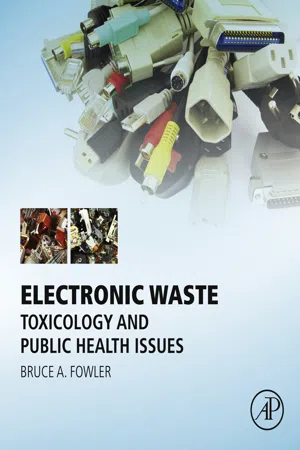
- 100 pages
- English
- ePUB (mobile friendly)
- Available on iOS & Android
About This Book
Electronic Waste: Toxicology and Public Health Issues discusses the major public health concerns due to the presence of toxic chemicals that are generated from improper recycling and disposal practices of electronic waste (e-waste). This book highlights hazardous inorganic chemicals found in e-waste, including arsenic, cadmium, lead, mercury, gallium, iridium, and nanomaterials, also focusing on health issues related to the presence of BPA, styrene, and other plastic components and combustion products, while also identifying populations at special risk.
To provide readers with potential solutions to this global problem, Dr. Fowler presents risk assessment approaches using chemicals, mixtures, biomarkers, susceptibility factors, and computational toxicology. He discusses how to translate the information gathered through risk assessment into safe and effective international policies.
The final chapter is devoted to future research directions. This is a timely and useful resource for all those concerned with the health issues surrounding e-waste management and proper disposal, including toxicologists, public health and policy officials, environmental scientists, and risk assessors.
- Offers a well-researched, single authored book and draws attention to the need for better and more informed risk assessment and policymaking in this area
- Emphasizes the transference of electronic waste (e-waste) to developing countries where populations of concern include children working in recycling activities and impoverished groups with poor nutritional status and limited access to medical resources
- Reviews, in detail, the issue of exposure to chemical mixtures as a central feature of e-waste due to the presence of a number of organic and inorganic chemicals in modern electronic devices
Frequently asked questions
Information
Magnitude of the Global E-Waste Problem
Abstract
Keywords
1. Scope of the Problem
1.1. Electronic Waste Types
1.2. Quantities of Outdated Electronic Devices
1.2.1. Number of Devices per Year
1.2.2. Tonnage per Year
2. Refurbishing Discarded Electronic Devices
3. Recycling of Devices Manufactured With Newer High Technology Alloy Nanomaterials
4. Global Distribution Steams of E-Waste—Where Does It Go?
5. Uptake of Toxic Chemicals Originating From E-Waste Into Food
Table of contents
- Cover image
- Title page
- Table of Contents
- Acknowledgment
- Copyright
- Biography
- Foreword
- Preface
- Chapter 1. Magnitude of the Global E-Waste Problem
- Chapter 2. Metals, Metallic Compounds, Organic Chemicals, and E-Waste Chemical Mixtures
- Chapter 3. Toxicology of E-Waste Chemicals—Mechanisms of Action
- Chapter 4. Populations at Special Risk
- Chapter 5. Risk Assessment/Risk Communication Approaches for E-Waste Sites
- Chapter 6. Translation of Risk Assessment Information Into Effective International Policies and Actions
- Chapter 7. Current E-Waste Data Gaps and Future Research Directions
- Index